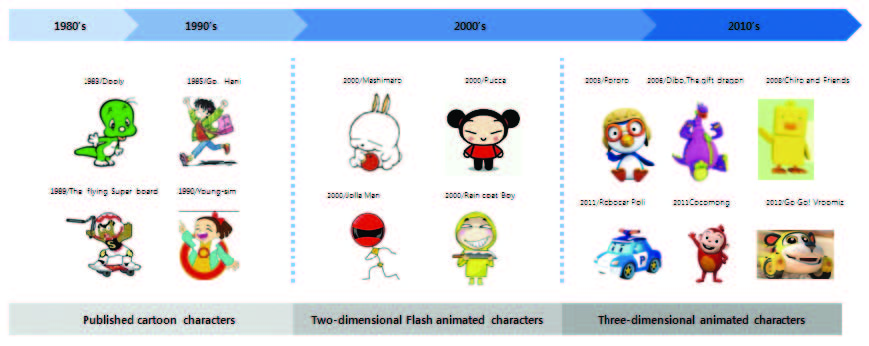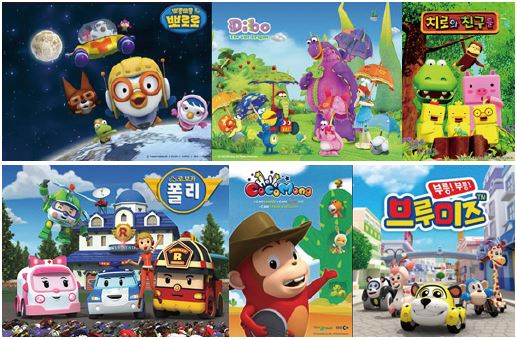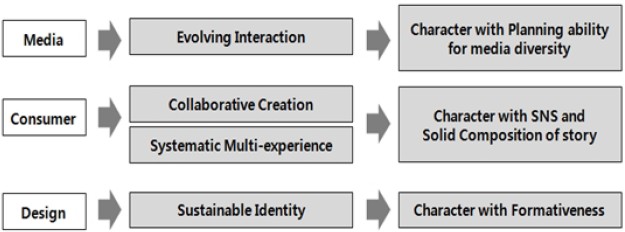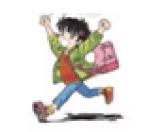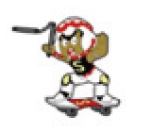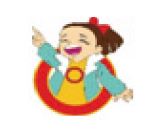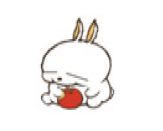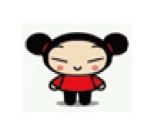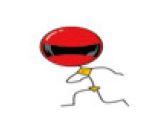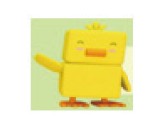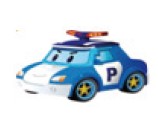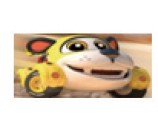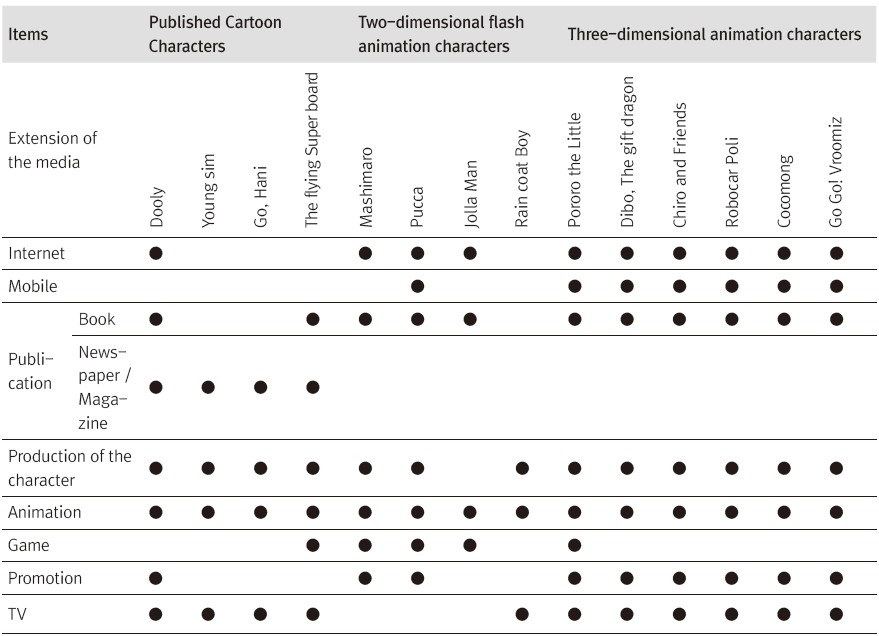
Periodic Features of Korean Character Designs
This journal was supported by National Research Foundation of Korea Grant Funded by the Korean Government(MEST)
이 학술지는 2013년도 정부재원(교육과학기술부)으로 한국연구재단의 지원을 받아 출판되었음
Background The character industry is growing significantly in its size worldwide. The Korean character market was dominated by overseas characters in the past, however, characters of purely domestic origins have gradually expanded their domain. The character industry emerges and matures with the advent of a new medium. The present study examines the periodic flow of domestically-produced character designs through the framework of media transition suggested by Marshall McLuhan, It also attempts to postulate the future directions the Korean character industry needs to pursue by predicting shifts in the media environment which the characters will encounter in the future.
Method We used the literature analysis and case study methods. We examined media formats through which domestic characters appeared and the peculiarities of the given media environment. We also created a classification system based on formative characteristics and story features, and selected and analyzed representative characters for each period in a given medium. Through the investigation of the representative characteristics for each period, we assessed the period-specific features of characters comprehensively. We then postulated formative features and story configurations for characters in a new media environment where they will make their entrance.
Results The analysis of the formative features revealed that figurative appearances gradually moved away from human forms and developed into characterizations of objects or animals. Color usages shifted from simplified flat-color-field composition to the adoption of three-dimensional effect and texture. Story structuring was targeted at preschoolers and was set in a background incorporating both the East and the West. The stories contained segmented educational contents and were planned as a series.
Conclusion To be able to achieve the potential for the OSMU expansion in an ever-changing media environment in the future, a character should be built on a solid storyline and should possess a formative uniqueness in its appearance and color. If characters could be planned with an emphasis on formative quality, story structuring, and media environment, the domestic character industry can anticipate accelerated growth within the strong technical infrastructure of information technology domestic market offers.
Keywords:
characters, media, formative features, story composition1. Background & Purpose
The character industry is expanding its size every year all around the world. The domestic character industry is also experiencing significant growth every year. A pattern that should be noted in this fast growth is that the dominance of overseas characters in the domestic character market is being replaced by that of characters of purely domestic origins, and domestically-produced characters are making their way into overseas markets. The Korea Creative Content Agency reports that in 2011, the sales of domestically-produced characters (3,631,600 million won) has outnumbered the sales of foreign characters (3,577,800 million won). These recent changes demonstrate that our domestic character industry has potential for continued growth for the future.
This study aims to assess the period-specific features of character designs from the past to the present in terms of their figurative aspects and story-building around them. We also attempt to provide a forecast on a new media environment in which the future characters will thrive so as to help the domestic character industry shaping itself for the future.
2. Methods & Scope
The scope of our character design investigation expands from 1980s to the current year of 2013. We classified our analysis targets into three groups based on the media in which the characters first appeared: Published Cartoon Characters, Two-Dimensional Animation Characters, and Three-Dimensional Animation Characters. We developed a classification system based on formative characteristics and story configuration. We then selected representative characters for each period, and conducted comparative analysis on the formative characteristics and story configuration for the selected characters.
By further analyzing period-specific features comprehensively, we derived peculiarities of character designs along with changes in media formats, and postulated the future directions for the characters in the ever-changing media environment.
3. Classification of domestically-produced characters based on media formats
The market flow for domestically-produced characters cannot be considered isolated from the media through which the characters made appearances. The media environment has changed profoundly since a notion of ‘character’ was first introduced in Korea, and in the current year of 2013, characters encounter very different media context.
Marshall Mcluhan (1964) argues that Mcluhan explains the correspondence between human senses and media through following classification: Primitive men lived in an era when communication was performed through the five senses of sight, hearing, touch, smell, and taste. With the invention of Gutenberg’s Printing Press, however, human communication started to rely heavily on the sense of vision. In ‘The Gutenberg Galaxy (1962)’, he asserted that reshaped the printed media have fundamentally reshaped many aspects of the Western civilization such as cognitive structure, culture, and social order. The emergence of TV in 1950s expanded utilization of our senses from vision to auditory sense. The medium of internet which first appeared in 1980s created demands for multifunctional senses incorporating sight, hearing, and touch. Mcluhan claimed that the medium of computer resembled human brain which controlled all physical activities. Technological evolution allowed expansion of human senses in communication. Advances in technology enabled expansions into multiple senses, realization of three-dimensional spaces, and more modification and control. The subsequent emergence of smartphone technology, with the added feature of mobility, penetrated deep into human life.
Designs of domestic characters have matured with the media transition. The market flow for domestically-produced characters can be classified into three periods based on media with respect to Marshall Mcluhan’s expansion of senses: First, the 1980s and 1990s, the era of published cartoon characters. Second, the 2000s, the era of two-dimensional Flash-animated characters fueled by the spread of internet. Third, the era of three-dimensional animated characters utilizing computer.
In 1980s and 1990s, cartoon characters that mostly appeared in the printed media dominated the domestically-produced character market. Like Bolter and Grusin (1999)’s claim that new media refashion prior media forms and gradually develops modes of expression unique to the new media, auditory elements were added to the existing contents and TV format contents were created. Characters first appeared through the format of printed media cartoons, and then evolved into animation format or cultural content development cases such as character products. In 1980s, the internet was not widespread and therefore many contents initially started as printed-media base and revealed a pattern of gradual expansion into other media.
In 2000s, the internet diffused widely, and the propagation of Flash program developed by Macromedia in 1997 enabled easy animation production utilizing small file size. This environment fueled creation of Flash animation, and Flash-animated characters began to lead domestic character market. When compared with the previous medium of print, the medium of internet soon exercised its inherent power of rapid transmission and spread. Thus, the characters appeared on the internet, gained recognition from a large number consumers, and were expanded into other media formats.
From the mid-2000s, with the advances in computer-based production technology, animation characters built in three-dimension instead of flat two-dimension appeared. The senses were extended from the domain of sight and hearing into the realm of visual touch, and images with enhanced reality became available. Characters were mainly created for a TV series at first, and were expanded into different media concurrently as they gained recognition. Table 1 shows comparative analysis between Marshall Mcluhan’s media classification and media classification for domestically-produced characters within the framework of senses and communication mode being utilized.
3.1. Period of Published Cartoon Characters (1980s~1990s)
It could be said that domestically-produced characters have their origin in <Dooly> which was created by Sujung Kim in 1993. Before Dooly, characters that enjoyed popularities internally were mostly overseas characters from the United States or Japan. The character of <Dooly> started as a cartoon character in a published cartoon in a printed medium. Little Dinosaur Dooly started its life in the comic magazine <Treasure Island> in 1983 and then was published as a comic book. In 1987, a TV animation was produced, and in 1996, a theatrical full-length animation was created. Dooly was expanded into various cultural contents sectors as OSMU (one source multi-use). OSMU(One Source Multi-Use) is a kind of sales strategy that develops contents service on various media such as book, movie and game. It is referred as Media franchise in America and Media mix in Japan.
Other cases of expansion form domestically-produced cartoons into character industry are observed besides Dooly (Sujung Kim). In 1980s, there are <Go, Hani> (Jinju Lee, 1985), and in 1990’s, there are <The Flying Superboard> (Youngman Heo, 1990) and <Young-sim> (Geumtaek Bae, 1990) (Figure 2).
<Go, Hani> started as published cartoon in the comic magazine <Treasure Island> in 1985, and was turned into a TV animation in 1988. <Go, Hani> is the first ever TV animation series in a drama format in the history of Korean animation. It is a touching story of a 7th grader Hani who grows into a bright gymnast overcoming her family tragedy. <The Flying Superboard> by Youngman Heo was first published in a printed medium under the title of <Mr. Hand> in 1989. It is a modern version of <Journey to the West> based on the traditional Chinese storyline. It adopts the classical background but with modern reinterpretation, and mainly covers the adventures encountered during the journey. <Young-sim> by Geumtaek Bae is a comic story about a 14-year-old adolescent girl Young-sim’s friends and family. <Young-sim> was published in a series in the Sports Newspaper, and enjoyed sympathy and popularity among many teenagers.
As factors that contributed to cartoon characters’ expansion into character industry in this period, Hak-Soon Im (2002) suggests the following. First, the 1980s had not yet seen the spread of internet and printed-media comic books were a major cultural contents medium for many. Second, characters of this period were supported by solid storylines which originated from creators’ imagination and background research. Third, these cartoon characters possessed highly symbolized iconic visual images.
3.2. Period of Two-Dimensional Flash Animated Characters (The early 2000s)
Internet use became widespread in the 2000s, and Flash was introduced as a moving-image creation tool for the internet. Flash-animated characters flourished in this environment. The Flash program developed at that time was a vector-based animation program which enabled easy animation production through relatively simple methods. Small file sizes allowed high-speed transmission, and vector-based graphic images did not turn blocky or pixelated. Graphics of various stage size or resolution could be generated, and the program provided optimal settings for online transmission. All these merits attracted internet users, and Flash diffused rapidly gaining much popularity. Representative Flash-animated characters from the period include <Mashimaro>, <Pucca>, <Jolla Man>, and <Raincoat Boy> (Figure 3).
<Mashimaro> is a cute rabbit-shaped character created by CLKO entertainment in 2000, and was introduced as 7-part episodes. At the time, the word “bizarre” was gaining popularity, and Mashimaro earned the nickname of “bizarre rabbit”. The character became widely popular among internet users, was developed into character products, and was exported to overseas markets. It attained a big success.
<Pucca> first appeared in Flash Animation “Pucca Funny Love” in 2000. Compared with other Flash-animated characters that appeared in the same period, a focus was put on character product development. <Pucca> penetrated overseas markets in 150 countries as well as domestic markets and gained huge success. Pucca’s figurative form resembling a little Chinese girl and strong contrast between red and black hues distinguishes itself from other characters.
Flash animation <Jolla Man> which appeared with <Mashimaro> in 2000 utilized computer modulated voice (for the control of tempo etc.) for the voice of the main character Bong Sun Hwa(棒線畵), and caught huge popularity. <Jolla Man> character’s physical form is extremely simplified. The character’s head is expressed with a circular form and simple thin lines are used for its body, arms, and legs. After the success of <Jolla Man>, characters utilizing similar physical forms flourished. Those characters were introduced in electronic books, puppet shows, and games, and enjoyed a long life and good expandability compared with other characters.
Unlike <Mashimaro> and <Jolla Man> built on the stories of bizarre behaviors, <Raincoat boy> is an unpredictable character with no particular thought pattern. <Raincoat boy> comically captured mentality in ordinary lives through stories derived from continuous happenings and accidents.
Mi-Hee Hong (2002) explains the dominance of Flash-animated characters in domestic character industry in the 2000s through the following factors. The first factor is the ease of production. Flash animation is vector-based, and therefore scaling does not harm the image quality. Flash animation files are also 1/16 of the regular moving image files in size, and allow high-speed transmission. Production in Flash thus had many advantages in terms of production-time and cost over the cell animation. The production method was also simple, so anyone could create Flash animation by familiarizing oneself with basic tools. The second factor is Flash characters’ ripple effect generated through internet penetration. South Korea has rapidly achieved high internet penetration rate. Flash animation pieces were introduced through the internet with constant intervals and reached a large number people. The third factor is unique story configurations that accompanied the Flash cartoon characters. Pre-Flash characters were embedded in stories mainly targeted at children, but Flash characters were involved in stories related to social issues of the time such as “yeop-gi (bizarre)” and “comic”. Such story configurations formed a consensus among adults as well as children.
3.3. Period of Three-dimensional Animation Characters (the mid-2000s)
3D ani]mation indicates moving images in three-dimensional spaces. In domestic markets, 3D animations are mainly produced with 3D STUDIO MAX or MAYA programs. Gyong-Ran Jeon (2010) defined the most distinctive characteristics of 3D animation as follows. First, whereas 2D animation characters are expressed on a flat space with X and Y axes, 3D animation characters are built with additional Z axis, and objects and backgrounds are rendered three-dimensionally. Second, 3D characters can acquire more realistic movement and texture compared with other production methods since they are modeled and rendered in three-dimensional space and then movements are added and produced like live action filming. Third, from the early stage, 3D animation characters are planned considering OSMU. Production cost for 3D animation is enormous when compared with 2D Flash animation. Therefore, 3D animation characters are developed with possibility of expansion into other media formats from the very beginning.
<Toy Story>, co-produced by Walt Disney Productions and Pixar Animation Studios in 1995, marked the first full-scaled appearance of 3D animation characters overseas. In domestic character markets, the first internally-produced 3D animation character was <Little Penguin Pororo> which was first aired on EBS in 2003. From this time, domestically-produced characters were planned as OSMU for overseas market penetration from the early stage. Target analysis and market research was thoroughly conducted. <Pororo> is an educational TV animation created for preschoolers with consideration of character merchandising from the beginning. <pororo>’s globalization strategy succeeded by adopting common character image favored by children all over the world and by developing educational story contents. <Dibo, the Gift Dragon> that appeared in 2006 differentiated itself from existing characters through unique texture of knit material and various colors. Enhanced musical elements and rhythms were also used. Story structure and relationships between characters were planned with focus on overseas market trend, and therefore attracted both domestic consumers familiar with foreign characters and overseas consumers. <Chiro and Friends> that appeared in 2007 was unique in that it adopted square-formed characters instead of established circular characters for the purpose of character merchandising. The shapes of characters were maximally simplified, and family-oriented storyline was more reinforced. <Robocar Poli> which was aired through EBS from 2011 was co-developed with toy manufacturer “Academy Science”. At the time, overseas characters ‘Thomas and Friends’ were sensationally popular in Korea, and <Robocar Poli> was developed by researching consumer trend about car-shaped character preferences. By applying imaginative features to cars, children’s all-time favorites, and by assigning functions and roles to cars, <Robocar Poli> visualized educational contents on traffic safety through simplified forms and colors favored by children. <Cocomong> is an animation with the purpose of educating proper eating habits for children. Various foods in the refrigerator are transformed into animal forms and provide friendly guidelines for balanced life through stories closely connected to children’s everyday lives. <Vroomiz> attempts to enhance visual sophistication of characters by combining car shapes children favor with animal forms. The characters were further diversified through the addition of special functions animals possess. In addition, <Vroomiz> is unique in that the character was expanded into the domain of a theme park as well (Figure 4).
4. Figurative Features and Story Composition
To identify the period-specific features of domestically-produced characters, character’s external figurative features and story configurations were analyzed by constructing a classification system.
4.1. Figurative features
The figurative features of domestically-produced characters were classified based on appearances and colors. Forms were first classified based on the object of characterization, and subdivided into the overall body shape, proportion, walking style, and the presence of hands and feet. Colors were subdivided by types of colors utilized, color effect, and visual texture. Table 2, 3, 4 show the figurative features of domestically-produced characters from each period.
Among the figurative feature of domestically-produced characters under “the object of characterization” category, in 1980s and 1990s, human-formed characters were the mainstream except for the character of <Dooly>. The mainstream for Flash-animated characters was human-forms as well except for <Mashimaro>. In the period of 3D animation character that began in 2003, characters were visualized as integration of animals and artifacts rather than as human-forms.
In terms of overall body shape, since human-formed characters were the mainstream in the printed media and Flash animation, most characters were largely confined to round shapes. However, in the period of 3D animation characters, characters were often imaged after animals and artifacts. Therefore, body shapes were not confined to circular forms anymore, and triangular and rectangular shapes were introduced. The proportion between the face and the body was mostly two-heads high with the exception of printed-media cartoon characters, or one body figure which reinforced the character’s peculiarity. For walking styles, most characters were 2-foot walk types, however, artifacts like cars were represented with four wheels instead of two feet. Hands and feet became more simplified as 3D animation characters prevailed.
In terms of color usage, Flash animation characters adopted the simplicity of 1 or 2 color use and created strong impact. 3D animation characters utilized simplified colors but produced three-dimensionality through gradation. Visual textures were also applied. Figurative features are compiled in Table 5.
4.2. Story Composition
Story configuration for domestically-produced characters were classified based on the target the character aimed to appeal, the story’s theme, the background for the story, and the plot which is the development of story.
The story for the leading domestic characters from 1980s to 1990s were of highly educational nature. The story contents mainly covered themes often found around us such as the love for family, experience of adolescent period, stories of overcoming adversity, and the good triumphing over the evil. The ages of target audience were mainly centered on childhood and adolescence.
Domestically-produced Flash animation characters that appeared in 2000s exhibited a little absurd or outrageous behavior, and appealed with humor and wit. The dictionary meaning of ‘Yeop-gi (Bizarre)’, the popular word in 2000s, is – markedly unusual in appearance, style, or general character and often involving incongruous or unexpected elements. Bizarre behaviors of characters functioned as an outlet for contemporary people who experienced much stress, and pleased them. Especially, the contents parodied Commercial Films, movies, and dramas that were popular at that time. The target audience included not only children but also a wide range of age groups.
Stories for domestically-produced 3D animation characters whose era began with the appearance of <Pororo> in 2003 were mainly targeted at preschoolers. Therefore, focus was laid on educational contents. Stories included educational contents for specialized themes such as language acquisition, learning number concepts, proper eating habits, and traffic safety. The backgrounds for the stories were not limited to Asian cultures and included the Western culture as well so that the stories could be expanded globally through OSMU.
After the 2000s, story development moved away from simple narrative pattern and evolved into a themed series production. Character’s storyline for each period is summarized in Table 6. Table 7 shows the compilation of story feature classification.
5. The media transition process for domestically-produced characters and features for each process
Before the advent of internet, published cartoon characters were introduced to the public through printed media. After gaining success through the printed media, they were expanded into TV animation, theater animation, and character commercialization. No plans for OSMU were included at the time of the character production (Figure 5).
2D Flash animation characters were created in Korean internet environment which achieved the top penetration rate in the world. Anyone could easily produce Flash characters without huge financial investment, and the characters spread to the public through the internet media. Afterwards, the characters were expanded into TV animation, printed-media published cartoons, and character merchandising (Figure 6).
3D animation characters were created with the plan of OSMU from the early stage, and thorough market research was conducted. They were produced as TV series animation in order to gain public recognition since the media format was considered to be the most effective for the continual enhancement of character recognition and for the communication of the character’s storyline. This was made possible by the emergence of various media channels consumers can approach such as cable TV that was introduced in Korea in 1995 and IPTV introduced in 2008.
Table 8 shows the media expansion of domestically-produced characters. As the era of 3D animation character is approached, characters enter more various media formats.
6. The direction of future development for domestically-produced characters
With current penetration of smartphones, domestically-produced characters will evolve into future directions differentiated from possibilities the existing media can offer. As Henry Jenkins (2006) argued in ┌Convergence culture┘, with the spread of smartphones, many people in the global village came to share contents with more information and culture in the virtual space through the new platform with added feature of mobility. Therefore, characters are gaining recognition through games utilizing smartphone as their main platforms (Figure 8).
As an overseas case, <Angry Birds> released in 2009 can be presented. <Angry Birds> was developed by Rovio Entertainment in Finland. It was introduced as a smartphone game and the story is about angry bird’s revenge on pigs who stole their eggs. With drastic increase of smartphone users, the character spread around the world very rapidly.
Similarly, in domestic market, there is a case of mobile game <Anipang> based on mobile messenger Kakao Talk. <Anipang> was created by Sunday Rose in 2009. <Anipang> allows score competitions among users, and spread rapidly through Korean Kakao Talk users. Jeong-woong Lee (2012) attributes <Anipang>’s success to the following three factors. First, the game utilized Kakao Talk platform which had already secured many members. Second, the game has very simple rule and can be easily accessed by anyone through simple downloading. Third, the game allows interaction among acquaintances and creates increased intimacy.
Both <Angry Birds> and <Anipang> achieved huge success as games, but they reveal a big difference in OSMU aspect. In the case of <Angry Birds>, the contents are being expanded into character merchandising, movie, animation, book, SNS, console, etc after the success of the smartphone game. In contrast, <Anipang> has not been successful in media expansion after gaining success as a game.
The success of <Angry Birds>’s OSMU is attributable to two main factors. First factor is original character configuration and story setup based on adventure, competition, conflict, caring and love. The story of the birds overcoming difficulties to take revenge on the pigs who stole their eggs reflects the challenges of human life, and users experience vicarious satisfaction. Comic elements are also present in the story allowing the story to attract a wide range of age groups from children to adults. In addition, the story was combined with successful established contents such as Star Wars, and was able to secure stronger expandability.
The second success factor is the formative qualities of the game characters. Shapes and features of various birds are formatively well captured and offer the feeling of intimacy. Diverse usage of colors and effects induced higher concentration on the screen. In contrast, <Anipang> only offered the simple game rule and did not have a storyline that could be expanded into other media. The game characters also did not possess distinctive formative features.
7. Conclusion
Domestically-produced character industry that started from <Dooly> in 1980s has progressed until present, the year of 2013, embracing unique features in ever-changing media environment. The characters have evolved assuming certain peculiarities in formative features including as shape and color, and in story configuration.
Chang et al (2013) defines the characteristics of tansmedia by taking three aspects into account: ‘evolving interaction’ in terms of media, ‘collaborative creation’ and ‘systematic multi-experience’ in terms of consumer, and ‘sustainable identity’ in terms of design. They suggest that the respective aspects are not independent and influence one another producing synergy.
Future prospects for domestically-produced characters can be postulated in relation to the characteristics of tansmedia.
First, in terms of ‘evolving interaction’, demands for characters with the potential of more functional and cognitive interaction are anticipated through the innovative media format that will newly emerge. In the future, patterns of content expansion into various media are expected on the basis the smartphone platform with mobility. Therefore, contents should be developed not only considering the smartphone environment but also taking account of potential application for various media formats.
Second, in terms of ‘collaborative creation’, more importance should be given to user behaviors by developing characters with stronger ties to social media that enable communication with multiple people. Preference for certain character can be enhanced by emphasizing social interaction based on the user participation through the character.
Third, in terms of ‘systematic multi-experience’, characters should be planned within spatial and temporal environments that enable diverse sensory experience for users. In order to achieve that, solidity of story configuration is pivotal. Domestic characters produced after mid-2000s only achieved a limited target audience of preschoolers due to this story factor. To create characters that can appeal to teenagers and youths, the characters should be built on a story with diverse themes and intriguing backgrounds.
Fourth, characters with sustainable identity are demanded. To attain sustainable identity, emphasis should be given to the formative quality of character’s distinctive shape and color on the basis of solid storyline. Characters with distinguished formative qualities can gain consumers’ affection regardless of time (Figure 9).
Domestically-produced characters are gradually penetrating larger markets, and annual sales are steadily increasing. If characters could be planned with emphasis on formative quality, story structuring, and media environment, domestic character industry can anticipate accelerated growth within the strong technical infrastructure of information technology domestic market offers.
Acknowledgments
This work was supported by 2013 Yonsei University Research Fund.
Notes
This is an Open Access article distributed under the terms of the Creative Commons Attribution Non-Commercial License (http://creativecommons.org/licenses/by-nc/3.0/), which permits unrestricted educational and non-commercial use, provided the original work is properly cited.
References
- Bolter, D. J., & Grusin, R. (1999). Remediation: understanding new media. Cambridge: The MIT Press.
- Chang, D. R., Chang, D.R., & Kwon, S.K. (2013). Transbranding based on media expansion and change. Korean Society for the Science of Design, 26 (1), 435-463.
- Choi, D. I. (2008). A Study of Successful Strategies through Case Analyses of Korean Animated Movies -Focusing on Pororo, Backkom, Iron Kid, and Dinosaur Dibo. Korean Society for Computer Game, 13, 93-98.
- Han, I. W. (2005). A Study of the Recent Condition Analysis of Domestic Character Industry and Revitalized Strategy -Focused on Fancy Character-. Korean Design Knowledge & Industrial Forum, 11, 515-530.
- Hong, M. H. (2002). A study on distinctions and successful elements of flash animation: Focused on distinctions of existing. Cartoon & Animation Studies, (6), 172-190.
- Hwang, S. J. (2010). A Study on Morphological Analysis of 3D Animation Character. The Korean Society of Design Culture, 16 (2), 458-464.
- Jenkis, H. (2006). Convergence culture: where old and new media collide. New York: NYU Press.
- Jeon, G. R. (2010). Visual textuality of stereoscopic 3D animation. Cartoon & Animation Studies, (20), 31-45.
- Kotler, P. (2010). Marketing 3.0: From Products to customers to the Human Spirit. Hoboken: Wiley.
- Lee, S. H. (2002). The Study on Plan to Activate Character Business. Korean Society for the Science of Design, 5 (1), 65-74.
- Mcluhan, M. (1962). The Gutenberg Galaxy. Toronto : University of Toronto Press.
- Mcluhan, M. (1964). Understanding Media-The Extension of Man. Cambridge: The MIT Press.
- Miller, C. H. (2004). Digital Storytelling. Waltham: Focal Press.
- Yim, H. S. (2002). The Successful Factors for Character Licensing Business and Policy Issues -In the Case of Licensing Business for Dooly Character-. Essays on cultural economics, 5 (2), 95-112.
